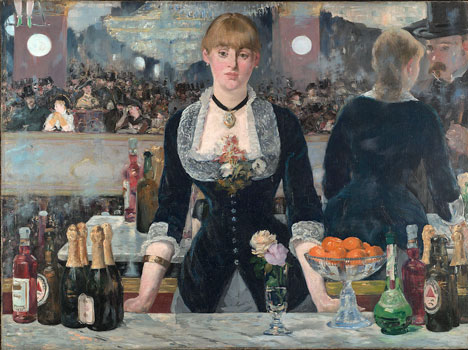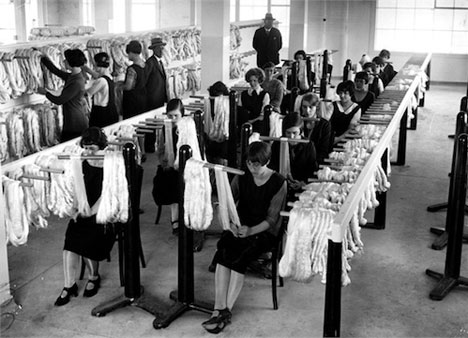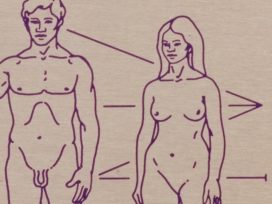[… ]mannequin-women, sexualized machine bits, masks, surfaces, and detached, cropped or distorted body parts embalmed in crystalline abstraction.
– Rebecca Comay
This is an essay about gender in crisis. By returning to the interwar years – a period of economic depression, technological transformation and class recomposition – I hope to pose questions that resonate with our present moment of crisis. Though both feminist and Marxist, my approach is not an attempt to comprehend the mutual articulation of gendered oppression and capitalist exploitation in toto. Instead, it proceeds through the analysis of a flimsy mass produced commodity at the time of its invention: the artificial silk stocking. In 1930 an advertisement hung in the window of Saks Fifth Avenue in New York City proclaiming: “Rayon is like the times we live in!” Today we would need to find another metaphor, but picking through the long-discarded materials of history provides ways of both understanding and unsettling present configurations.
I.
Edouard Manet’s A Bar at the Folies-Bergère was first exhibited at the Paris Salon in 1882. Contemporary reviewers expressed conflicting opinions on the painting’s merits but seemed to agree on one thing: this was a painting of modern life.

Un Bar aux Folies-Bergère, Edouard Manet, (1882), Oil on canvas, 96cm × 130cm; Courtauld Gallery, London. Source:Wikimedia
At the centre of a display of commodities stands a saleswoman, who, it has been historically assumed, is herself on sale. She is engaged in a transaction with a male customer from whose skewed perspective we view the scene. Her expression is detached, vacant, distracted – her stillness at odds with the bustling crowd in the background. Fashion fashions the modern female subject-object – she dresses according to an ideal, a type. The world that appears reflected in the mirror behind her is all wrong. It presents a counterfeit version of reality – dazzling, ephemeral, off-kilter. It is a painting of surfaces that also draws attention to the surface of the painting itself.
“This gaudy blue dress, surmounted by a cardboard head like those one used to see in milliners’ shop windows, represents a woman… this mannequin of uncertain form whose face is slashed in with three brushstrokes represents a man”, sneered one reviewer. The painting evokes window displays; it is governed by the emergent logics of mass consumption. Women and men are replaced by artificial substitutes. Relations between people become relations between things. And this painting of commodities emphasizes the commodity form of the painting itself.
II.
In 1926, Samuel Courtauld purchased A Bar at the Folies-Bergère for 22,600 pounds. Courtauld, who became chairman of his family’s textile business in 1921, was disdainful of what he called the “Americanization of Europe” and its “degraded” cultural output. He hoped that his private art collection could be used to enlighten the British public. The money to pay for this high-minded gesture was generated from the production of artificial or “art” silk – the world’s first synthetic fibre.
Hollow subjects formed in the image of commodities, primped displays of female bodies, cosmetic masks concealing nothing, interchangeable mannequin-like entities, mass produced souls, seductive but brittle visages – the anxieties that Manet’s painting provoked were amplified in the 1920s and 1930s, keeping pace with the continued development of mass production and consumption. Art silk stockings became a cipher for the crass Americanization that Courtauld deplored. This flimsy little object is just as instructive as any Impressionist masterpiece.
“In a decaying or transitional world, whose elements fall asunder, the objects rush out of their hiding places and take on a life of their own […] a broken mirror emerges and like a witness tells of glamour and destruction […] all human values are doomed unless we change society radically”, proclaimed Siegfried Kracauer in his analysis of interwar German cinema. In Europe between two world wars, a decaying or transitional world, the art silk stocking – cheap, synthetic, insubstantial and feminine – emerges witness-like and speaks of glamour, destruction and gender in crisis.
III.
In his 1933 novel Love on the Dole, Walter Greenwood describes women workers leaving a factory in Northern England:
Clatter of clogs and shoes; chatter of many loud voices; bursts of laughter. Hundreds of girl operatives and women from the adjacent cotton mills marching home to dinner arm in arm… A generation ago all would have been wearing clogs, shawls, tight bodices, ample skirts and home-knitted, black wool stockings. A few still held to the picturesque clogs and shawls of yesterday, but the majority represented modernity: cheap artificial silk stockings, cheap short-skirted frocks, cheap coats, cheap shoes, crimped hair, powder and rouge.
“Cheap artificial silk stockings” represent the modern women they adorn.
The 1934 musical comedy Sing As We Go stars Gracie Fields as a plucky young mill worker from Lancashire, laid off when her textile factory ceases production. Fields’ character is a prototype of the ideal capitalist worker in a time of crisis. She is chummy with the boss, acting as a mediator between him and the docile workers, who only seem mildly disgruntled at the announcement of closure.
Instead of protesting or joining the dole queue, our chirpy heroine heads off to Blackpool Pleasure Beach in search of work. She flits between casual jobs, including a stint as a human spider in a music hall review – the spinning of theatrical cobwebs a kitsch parallel to her previous role in the factory. Along the way she encounters a textile magnate and is instrumental in persuading him to re-open the mill for the production of a new fibre: artificial silk. The film ends with her leading her colleagues back to the factory. The workers’ bodies, moving in time to her jaunty tune, merge with the re-animated machinery.

Rayon factory workers, 1926
During the depression, mass unemployment – 25 per cent of the British workforce in 1933 – was not so simply or cheerfully resolved as in this upbeat caper. But as the labour exchanges swelled in Britain’s traditional industrial heartlands, new factories producing new consumer goods began to open.
In his bestselling travelogue An English Journey (also from 1934) J.B. Priestley, who wrote the screenplay to Sing As We Go, famously outlined three visions of England. The first two Englands already belonged to the past: a pastoral ye Olde England of yesteryear and an industrial England of the nineteenth century. The present he describes comes from America:
This is the England of arterial and by-pass roads, of filling stations and factories that look like exhibition buildings, of giant cinemas and dance-halls and cafes, bungalows with tiny garages, cocktail bars, Woolworths, motor-coaches, wireless, hiking, factory girls looking like actresses, greyhound racing and dirt tracks, swimming pools, and everything given away for cigarette coupons.
This is a stark contrast to his sturdy and sooty second England. Despite the bleakness of that devastated landscape, there is a tragic grandeur to those industrial wastelands with their stoical inhabitants and hefty output, wrenched from the bowels of the earth. The new England is bright and clean but flimsy, frivolous and feminine. “Factory girls looking like actresses” are the only human figures that populate this shiny world; the producers and consumers of a superficial and artificial life of leisure among mass-produced commodities.
In 1936, George Orwell set out to document working class life in the Northern English industrial town of Wigan, describing himself as “a civilized man venturing among savages.” Orwell remarked upon the proliferation of cheap luxury goods in the midst of economic depression, declaring it likely that “fish-and-chips, art-silk stockings, tinned salmon, cut-price chocolate (five two-ounce bars for sixpence), the movies, the radio, strong tea, and the Football Pools have between them averted revolution.” But Orwell was disdainful of indulging in daydreams, which he insisted were private rather than collective. These distractions were “cheap palliatives”. Daydreams distract from reality and thus perpetuate the existing state of things.
A year later, the Mass Observation project, which explicitly sought to apply anthropological methods to the English working classes, went to Blackpool which, as Sing as You Go makes clear, was taken to exemplify emerging working class leisure culture. Lickable candy torsos, male comedians in brassieres, pier-end slot-machines offering titillating glimpses of breasts and thighs, an “intersexual” celebrity, a waxwork of a pregnant male – the observers described the popularity of dissected and hermaphrodite bodies in Blackpool’s entertainments – “for a week you change the routine, the restrictions, the laws of everyday, and even the laws of nature”. These middle class interlopers assumed – wrongly as it turned out – that this smutty paraphernalia’s playful inversion of gender roles indicated a lack of sexual decorum, particularly on the part of women.
The communist writer John Somerfield, recently returned from the Spanish Civil War, was among the observers. His account of an encounter with some drunk and flirtatious “dirty girls” in a Blackpool pub is laced with revulsion, a thinly disguised disgust for working class women more clearly revealed in his novel May Day (1936):
These silly girls with their synthetic Hollywood dreams, their pathetic silk stockings and lipsticks, their foolish strivings to escape from the cramped monotony of their lives, are the raw material of history.
Class consciousness is here replaced with a state of homogenous, though not communal, unconsciousness – a state of bedazzled stupor with none of the seething depths of the Freudian Unconscious. Unlike Greenwood and Orwell, Somerfield imagines these “silly girls” wearing real silk stockings. But the art silk stocking is the true counterpart to the synthetic dream – a shiny artificial surface veiling, without effacing, the drabness of reality.
IV.
Herbert Casson, in his impassioned paean to the economic possibilities of the emergent art silk industry, noted that the new fabric was initially greeted with incredulity – “they weave stockings out of cabbages!” Artificial silk is made from regenerated cellulose. Organic plant tissues are dissolved, steeped in acid, dissolved again, filtered and spun to create a fine fibre. But just as silk stockings were not associated with the domesticated mulberry-leaf munching insects responsible for spinning silk, so art silk was divorced from the organic matter it derived from – vegetable matter and human labour transformed into glimmering commodities to generate something even more insubstantial and beguiling: value.
Chemists were searching for a substitute for silk but created “a new fibre with qualities all of its own”. According to the British Committee on Industry and Trade’s Survey of Textile Industries (1928):
Artificial silk differs from natural textile fibres in being a continuous smooth filament without scales or protruding hairs… Among the principle advantages of artificial silk are the softness and lustre of the fabrics made from it. Owing to the smoothness of the filament, cloth woven from it will not readily catch dirt.
Clean, smooth, soft and shining – art silk is not raw material, but an organic material submitted to a chemical process. Like this new fibre, British women in the interwar years could no longer be aligned with the organic world. Made-up, machine-operating, movie-going “girls” were not pitiful casualties, passive flotsam churned up by the movement of history, not merely “raw material” but semi-synthetic and formed by modernity. Synthetic dreaming was part of the fabric of an emerging synthetic reality. And as Walter Benjamin perceived “dreaming has a share in history”.
Experiments with high-power explosives and electric lights gave birth to the world’s first synthetic yarn.
The French chemist Chardonnet exhibited the new fibre at the International Exhibition in Paris in 1889. In 1892 British chemists patented a substance called “viscose” by treating wood pulp with caustic acid and other chemicals. The Courtauld Textile Company was the first to mass produce the new invention in Britain.
Courtaulds made their name by trading in death. The company made vast profits by specializing in the production of mourning crêpe. The elaborate formal mourning rituals of Victorian England demanded that wealthy women conspicuously display their sorrow. The fabric was not only consumed in response to death – its production was as mortifying as any sector of Britain’s nineteenth century textile industry, the analysis of which forms the basis of Karl Marx’s Capital.
In response to the dwindling demand for crêpe, Courtaulds bought the patents for viscose and artificial silk in 1904. A factory was built in Coventry to produce the new yarn, which was approved for the production of stockings in 1912. The American explosives manufacturer DuPont joined the fray in the 1920s, introducing the name “rayon” which was intended to gesture towards the fabric’s lustrous appearance. Despite being marketed to female consumers as a “man-made” material, women workers outnumbered men in the British artificial silk industry. In the interwar years, in the midst of crisis and depression, the global output of rayon rose from 13 million kg to 1000 million kg – a 7,600 per cent increase. Competition drove down the price, making it affordable for working class women. Art silk imitates silk which in turn allowed working class women to imitate those who could afford real silk.
The labour of the living congeals into commodities displayed on working female bodies. “Lovely soft silken things that will wear and wear” – the fabrics have a contradictory quality. Courtaulds advertisements describe their new fabrics as sheer but durable, “diaphanous or substantial”. The synthetic properties of the fabric enable it to “resist the hard wear to which the customs of modern life subject them”. Human bodies are not so resilient. In the rayon industry, labour disputes focused on working conditions rather than wages. Workers complained of sore eyes and were concerned about the effects of the factories’ “offensive effluent and bad smells”.
Rayon stockings not only imitate silk but also form a second skin – dirty champagne, beige, taupe, gunmetal grey – rough and mottled flesh coated with a monochromatic glaze, concealing the corrosive effects of production. After their shifts, women workers could pull sheer surfaces over exhausted legs, daub themselves in cosmetics and go for a night out. Lipstick tints were also transformed by innovations in the chemical industry. Launched in 1921, Chanel No 5, a compound which used benzyl acetate (derived from coal tar) as a base, ushered in a trend for perfumes that bore no resemblance to the fragrance of flowers. Coco Chanel saw the proliferation of copies that rolled off the assembly lines in the wake of her signature scent in a positive light – proclamations of originality ring false in a world of synthetic analogues. Dressing up is not a return to some imagined lost organic whole, it eschews biological destiny – femininity is masquerade.
“Loveliness fortified against air and sun and soiling,” announces a Courtaulds Fabrics advertisement from 1931. The delicacy and daintiness of rayon yarns are repeatedly associated in these magazine promotions with the supposedly natural attributes of women. Another advertisement juxtaposes two images – a female pilot dressed in her flying garb and the same woman relaxing in art silk lingerie – declaring: “Modern woman retains her effeminate daintiness”. Rather than representing a break with nature, Courtaulds rayon fabrics are shown to uphold the division of the sexes. Women masculinized by the sphere of production must be feminized by the sphere of consumption, but those two discrete poles are never abandoned. In the face of concrete transformations in gender relations, synthetic substitutes are required to create the appearance of a division that cannot be found in the biological realm.
V.
On the boards advertising work outside factories unskilled women were referred to metonymically as “hands”. Advertising billboards and magazine spreads show dissected female bodies to different effect. Replicating the perspective of Freud’s archetypal male fetishist, stocking commercials detach legs from bodies. The stockinged shin functions as a metonym for female sexuality. But there is more to synthetic dreaming than the well-rehearsed dichotomy between male gaze and female glaze.
Cinemas were the dream palaces of the interwar working classes. Marlene Dietrich, Jean Harlow, Greta Garbo – screen sirens in ermine and pearls were rarely shown in domestic settings. Orwell described women in Wigan dressed as counterfeit movie stars. Celluloid film was made from the same chemical formula as viscose rayon. Stockings screened the flesh and giant fragments of body were projected in black and white on the silver screen.
In 1937, the novelist Elizabeth Bowen reflected on her own cinema-going habits, describing an experience of emotion, distraction, beauty, “unlikely energy… preposterous pattern…bright light, abrupt shadow, speed”. She saw the cinema as an antidote for lassitude. Cinemas were built from new materials – “concrete succeeds stucco and chromium gilt” – and ushered in new modes of perception. For Bowen, glamour is a key element of the experience:
What do I mean by glamour? A sort of sensuous gloss: I know it to be synthetic, but it affects me strongly. It is a trick knowingly practiced on my most fuzzy desires.
Knowingly subjecting oneself to glamour is not a form of stupor but a conscious fantasy. Synthetic dreaming has an emancipatory aspect. Bowen describes the bond formed between the audience and the giant stars projected on the screen as “inoperative love” – a form of human intimacy that demands nothing of the spectator. In a society in which relationships are structurally unequal, entering a space where the strains of reciprocity are suspended provides respite from “the necessity to please, to shine.” The challenge then is for the fuzziness of desire to come into sharper focus. A new collective might emerge from the darkened movie theatres, blinking their mascaraed lashes in the neon lights of a world that might be re-made in the image of the unfettered lives projected on screen.
VI.
Georgio Agamben discusses an advertisement made for Dim Stockings in the 1970s, which shows five women – “long legs sheathed in the same inexpensive commodity” – dancing in different rhythms to the same tune. Agamben locates the emergence of the commodified female body in the interwar years, linking the advertisement to Siegfried Kracauer’s “The Mass Ornament” (1927), which treats the vogue for geometrically precise mass dance formations pioneered by the American Tiller Girls as a metaphor for capitalist society. The performance slashes up bodies into their constituent parts – “arms, thighs and other segments” – and transforms a community into interchangeable components, each with no conception of the whole of which they are a part.
In The Salaried Masses, completed in October 1929, the month of the Wall Street Crash, Kracauer undertook an analysis of an emergent white collar class in Berlin. Like his British contemporaries, Kracauer adopted an anthropological methodology, setting out to observe a life that “is more unknown than that of the primitive tribes”.
Lingerie firm employees, shorthand typists, secretaries, cigarette and perfume salesgirls, soft furnishing specialists, soap manufacturers, switchboard operators, draper’s assistants, card punching girls and filing room clerks – Kracauer’s masses do not produce commodities, they facilitate their circulation. A woman who sells stockings in a department store is fired for advising her friend that she might find something cheaper elsewhere. Although Kracauer notes that statistically under half of this fledgling class is female, the examples he cites are almost exclusively “girls”.
Despite the fragrant odours and sleek contours of this new world, Kracauer describes how the process of rationalization functions to transform workers into an army of “mutually interchangeable private soldiers”. The logic of the assembly line that governs production also extends to new patterns of mass consumption – “speech, clothes, gestures and countenances” – all are standardized. Love letters are stamped and filed like office bureaucracy. Fungible individuals are forged in the image of advertisements, glossy magazine spreads and window displays. “In the window of one large department store, mannequin dolls strut about in cheap ready-made clothes among fancy orchids.” Kracauer’s insubstantial mannequin-like girls work by day, then dress up and head out into the artificially illuminated night. “Just as hypnotists use glittering objects to put their subjects to sleep”, in the Luna Park, the movie theatre, the dance hall or the cabaret bright colours, glamorous images and upbeat tunes function to block out the tedium, drabness and monotony of the eight hour day.
Christopher Isherwood’s emerald-nailed cabaret singer Sally Bowles is the daughter of a Lancashire mill-owner adrift in Weimar Berlin, perhaps funding her prairie oyster habit from the profits of the new rayon industry. Interwar Germany was the world’s third largest producer of artificial silk (Kunstseide) and the German chemical industry led innovations in enhancing the tactility of the fabric. Former munitions factories were transformed into rayon mills. Marlene Dietrich, whose legs featured prominently on billboards for the 1930 movie The Blue Angel, was also the face (or thighs) of Bemberg stockings. In 1938 the Nazi film studios UFA produced a propaganda film, On a Silk Thread, that told the story of a war-devastated town being revitalized by the establishment of an artificial silk mill – a chilly counterpart to its jaunty British precursor, Sing as We Go.
Irmgard Keun’s bestselling 1932 novel The Artificial Silk Girl tells the story of glamour-obsessed young woman who comes to Berlin in pursuit of fame but eventually joins the ranks of the salaried masses. She is exhilarated by the city’s neon lights, teeming crowds and rushing subway trains: “all colours and whirling lights […] red and shimmery […] luminescent grapes [that] glitter and fountains that spray a very fine mist […] I was completely in a trance”. This twinkling terrain recalls Kracauer’s description of an illuminated fountain in the city’s Luna Park:
Cones of red, yellow and green light, continually recreated, flee into the darkness. When the splendour is gone, it turns out to have come from the wretched cartilaginous structure of a few little pipes. The fountain resembles the life of many employees. From its wretchedness it escapes into distraction, lets itself be illuminated with Bengal lights and, unmindful of its origin, dissolves into the nocturnal void.
But Keun’s dazzling landscape with its pearl necklaces, rich hazelnut tortes and champagne flutes is also strewn with cigarette butts and dead cockroaches. The lights never succeed in obscuring the pipes. No amount of eyeliner can compensate for her sallow skin and protruding hip bones: “I love Berlin but my knees are trembling and I don’t know what I’m going to eat tomorrow.” Politicians and police are everywhere. Sartorial details give the game away: her red dress is elegant but torn, her high heels broken, her lipstick cadaverous. Her synthetic dreams, like her art silk stockings, glimmer but are easily torn.
VII.
Corpse A
They brought her in, a shattered small
Cocoon,
With a little bruised body like
A startled moon,
And all the subtle symphonies of her,
A startled moon,
A twilight rune.
From “Suicide” by Djuna Barnes
Walter Benjamin described The Salaried Masses as an interpretation of a political dream. For Benjamin, contra Freud, dreams are oriented towards the future – “Each epoch dreams the one to follow”. Fashion similarly reveals the signs of a world to come:
the incomparable nose which the feminine collective has for what lies waiting in the future. Each season brings, in its newest creations, various secret signals of things to come. Whoever understands how to read these semaphores would know in advance not only about new currents in the arts but also about new legal codes, wars, and revolutions.
This would imply that the atomized feminine collective that Kracauer describes consists of little more than docile fascists-in-waiting, sleepwalking their way towards Nazism. How to awaken from the dream?
In The Arcades Project, based on notes gathered between the wars, Benjamin suggests that the convergence of woman and commodity, epitomized by the figure of the prostitute, begins in Paris, capital of the nineteenth century. We return to the bar at the Folies-Bergère. Already we see the familiar features emerging – “dolls on chairs, mannequins with false necks, false hair, false attractions” – “mania for masks” – “fanatical love of masquerade” – stockings that “make for an ethereal meat counter”. Shop signs, window displays and advertising slice and sever – a disembodied stockinged leg hanging over the street accosts a passer-by like a ghost.
Benjamin does not gloss over the brutalities of this urbanized commercial landscape on women’s lives but he locates its violence in the exploitative economic system rather than in industrialization or technical innovation per se. Indeed, he affirms the inorganic against the organic. As Esther Leslie discusses, women, for Benjamin, are “pioneer explorers in a new continent of artifice”. Modernity denaturalizes gender – a tiny ember glows in the darkness that might still start a blaze. Similarly, Kracauer is not calling for a return to some a priori biological state. Humanity has taken a step in the right direction by beginning to make its “exodus from lush organic splendour”
but only by breaking with the current economic order might people consciously intervene in this process and halt the relapse into mythology.
Benjamin declared that dreamers wrap themselves in a “warm gray fabric lined on the inside with the most lustrous and colourful of silks”. For Kracauer, the young women who populated 1920s Berlin lived as though enveloped in cocoons. A cocoon is a casing spun of silk. Insects that pupate in a cocoon must escape from it. They emerge transformed. The invention of artificial silk saw the fine filaments spun by insects supplemented by semi-synthetic fibres spun by human workers. The women slumbering in bright rayon cocoons were not insulated from the devastation of history, but they should not be castigated for dreaming or blamed for the catastrophes that ensued. Something new might still grow wings and fly. Interpreting the synthetic dreams of the interwar years could reveal alternative futures that might have come to pass had the synthetic nightmares of the twentieth century been averted. But that would involve listening to the dreamers themselves.








